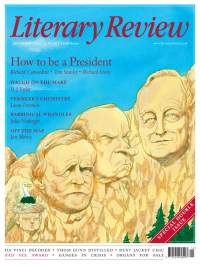Peter Parker
Imperial Designs
Picturing India: People, Places and the World of the East India Company
By John McAleer
British Library 224pp £30
The Company of Merchants of London Trading into the East Indies was granted its royal charter in 1600. This gave what became known as the East India Company a monopoly on all English trade ‘to the east of the Cape of Good Hope’. India became the principal focus of the Company’s operations, and by 1772, when it came to obtaining trade concessions there, its bargaining power was backed up by an army of some 25,000 men, largely recruited from the indigenous population but trained and commanded by British officers. Wars were fought for control of kingdoms, with defeated Indian rulers forced to cede administrative powers, including the collection of revenue, to the Company. Vast fortunes were made and the Company eventually became a sovereign power in India, establishing three ‘presidencies’ in Calcutta, Bombay and Madras and obtaining ‘possession of the labour, industry, and manufactures of twenty million subjects’. When in 1799 the governor-general, Richard Wellesley, planned the new Government House in Calcutta, largely modelled on Kedleston Hall, he argued that India should ‘be ruled from a palace, not a counting house; with the ideas of a Prince, not those of a retail dealer in muslins and indigo’. It all ended badly, of course, with the so-called Indian Mutiny of 1857, after which the British government, which had increasingly taken a role in overseeing the Company, decided to dissolve it and transfer its assets and political power to the crown.
John McAleer’s book charts the rise and fall of the East India Company through the European artists who portrayed Britain’s many-faceted engagement with the subcontinent. The result is a fascinating story of painting, power and patronage, generously illustrated with artworks mostly taken from the British Library’s comprehensive collection.

Sign Up to our newsletter
Receive free articles, highlights from the archive, news, details of prizes, and much more.@Lit_Review
Follow Literary Review on Twitter
Twitter Feed
It wasn’t until 1825 that Pepys’s diary became available for the first time. How it was eventually decrypted and published is a story of subterfuge and duplicity.
Kate Loveman tells the tale.
Kate Loveman - Publishing Pepys
Kate Loveman: Publishing Pepys
literaryreview.co.uk
Arthur Christopher Benson was a pillar of the Edwardian establishment. He was supremely well connected. As his newly published diaries reveal, he was also riotously indiscreet.
Piers Brendon compares Benson’s journals to others from the 20th century.
Piers Brendon - Land of Dopes & Tories
Piers Brendon: Land of Dopes & Tories - The Benson Diaries: Selections from the Diary of Arthur Christopher Benson by Eamon Duffy & Ronald Hyam (edd)
literaryreview.co.uk
Of the siblings Gwen and Augustus John, it is Augustus who has commanded most attention from collectors and connoisseurs.
Was he really the finer artist, asks Tanya Harrod, or is it time Gwen emerged from her brother’s shadow?
Tanya Harrod - Cut from the Same Canvas
Tanya Harrod: Cut from the Same Canvas - Artists, Siblings, Visionaries: The Lives and Loves of Gwen and Augustus John by Judith Mackrell
literaryreview.co.uk